Prof. Tao Yitao, Director of the China Center for Special Economic Zone Research (CCSEZR), Dean of the Belt and Road Research Institute of Shenzhen University (SZU), and President of the Belt and Road Research Institute (Shenzhen) for International Cooperation and Development (BRRIICD), visited Laos at the invitation of Vientiane Saysettha Development Zone (SDZ) from June 11 to 14, 2019.
Accompanying her were Prof. Cai Qiang, Deputy President of BRRIICD, Dr. Yang Hanxin, Advisor at BRRIICD and an energy expert graduating from the University of Manchester, Prof. Huang Yiheng, Associate Professor at CCSEZR, and Dr. Geng Shuang, a postdoc at the Postdoctoral Research Station of Theoretical Economics, Shenzhen University.
The SDZ in Vientiane is a national special economic zone (SEZ) in Laos, and a national overseas economic and trade cooperation zone of China. Set up in the early stage of the Belt and Road Initiative (BRI) of China, the SDZ is among the few SEZs that were nailed down by leaders of both countries.
On June 16, 2010, Yunnan Provincial Overseas Investment Co., Ltd., China Development Bank and the Vientiane government signed the Memorandum of Understanding (MOU) for Vientiane Comprehensive Development Project in the presence of Chinese President Xi Jinping (then Vice President of China) and Lao President Bounnhang Vorachith (then Vice President of Laos).
On November 18, 2010, the SDZ project kicked off. On August 17, 2011, the Lao government listed SDZ as a national development zone. On August 4, 2016, China's Ministry of Commerce and Ministry of Finance jointly issued the Confirmation Letter of Overseas Economic and Trade Cooperation Zone, officially listing SDZ as China’s national overseas economic and trade cooperation zone.
On November 13, 2017, Chinese President Xi Jinping mentioned that “impressive progress had been made in developing the Vientiane Saysettha Development Zone” in his bylined article on Lao mainstream media during his visit to Laos.

Gate of SDZ (left), SDZ planning (right)
Covering an area of 11.49 square kilometers, SDZ is positioned to be the core of Vientiane’s new urban district. Furthermore, it boasts an advantageous geographical location, only seventeen kilometers to the north-east of Vientiane’s central downtown and 1.5 kilometers to the Laos-China Railway slated to be open to the public in 2021. SDZ will focus on attracting and breeding trade logistics and agricultural products processing companies, with real estate development and services as supporting sectors. Following a principle that emphasizes openness, sharing and innovative, and coordinated, green development, Laos-China Joint Venture Investment Company, the operator of SDZ, is committed to making SDZ a modern comprehensive development zone that lays weight on systematic, holistic and synergic development, thus setting an example for other SEZs in Laos as a zone characterized by efficient operation, adequate facilities and pleasant environment. So far, SDZ has brought in about USD 500 million of investment from more than 45 companies from China and other countries spanning from agricultural product processing, power equipment manufacturing, through renewable energy production, trade and logistics, to machine manufacturing and industrial standards formulation.
On the morning of June 12, the first leg of Prof. Tao’s visit took her delegation to the Special Economic Zone Administrative Committee of Vientiane. They were warmly received by Thongphat Vongskykeo, Director of Laos Special Economic Zone Investment Promotion Department and Deputy Director of the Special Economic Zone Administrative Committee of Vientiane, and other officials from the same. Mr. Thongphat Vongskykeo introduced the development milestones, investment promotion, favorable policies for investors, and development goals of SEZs in Laos. Laos has set up 12 SEZs since 2002 when the first one, the Savan-SENO SEZ, was established. As of January 5, 2019, there are 593 companies settling in Laos’ SEZs, with a registered capital hitting USD 13.25 billion. Among them are 350 Chinese-funded companies, contributing to a registered capital of USD 22.49 billion. SEZs have created 25,015 jobs, with 9,149 jobs for Lao workers, exported as much as USD 1.28 billion in goods and services to other countries, and collected a tax revenue of USD 31 million. Currently, the Administrative Committee is building an SEZ database management system, in an effort to better serve the investors. Mr. Thongphat Vongskykeo said Laos was still in its infancy when it comes to the development SEZs, and the visit of Chinese delegation offered a great chance for them to learn China’s experience. He sincerely welcomed the Chinese delegation, and hoped that mutual exchanges between Laos and China could boost the development of SEZs in Laos.
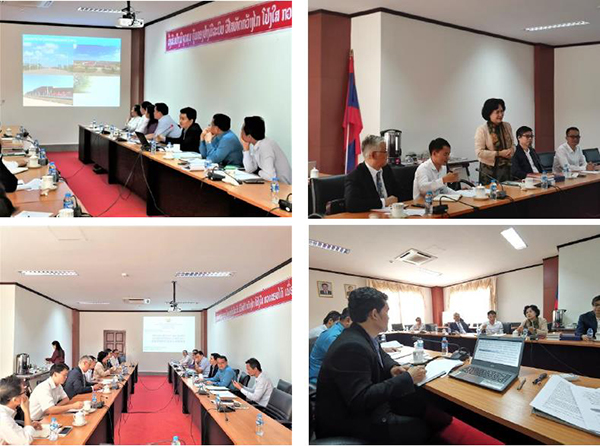
Thongphat Vongskykeo is introducing the SEZs in Laos (upper left). Prof. Tao is introducing the delegation (upper right). Prof. Tao is sharing SEZ development experience with Mr. Thongphat Vongskykeo (lower left). Prof. Tao is answering Mr. Thongphat Vongskykeo’s questions about Shenzhen SEZ (lower right).
Prof. Tao Yitao introduced the history, development and status quo on China’s SEZs. China’s SEZs primarily serve as the windows and testing ground for the country’s reform and opening-up, to compare with those in Laos whose prime task is to boost economic growth. Playing such a role requires SEZs in China to constantly innovate their concepts about development. Take Shenzhen SEZ as an example: With preferential business policies, Shenzhen has attracted a large number of immigrants from across China. It constantly innovates its concepts and avoids a lock-in situation in development by opening up to the outside world and adjusting industrial structure. With innovative concepts combined with capital and technology, it eventually puts its economy on a strong growth trajectory. Prof. Tao further introduced Shenzhen’s policies and measures for stimulating innovation. Shenzhen municipal government has set up a number of industrial parks, and provides loans and grants to tech start-ups that are aligned with the needs of its industrial development plan. It offers financial support and preferential housing policies for most-wanted talent. The government and universities also provide workplace and funds for young entrepreneurs. Particularly, she mentioned that Shenzhen municipal government was devoted to becoming a service-oriented government to better serve companies and the public by decentralizing power.
Her introduction aroused great interest of Lao government officials who frequently asked questions, extending the meeting from 1.5 hours as planned to more than two hours. The meeting was brought to a successful close amid a warm atmosphere. Then, Prof. Tao presented the English edition of the Annual Report on the Development of China’s Special Economic Zones (2018) (Blue Book) and China’s Economic Zones: Design, Implementation and Impact, and Shenzhen University badge to Laos Special Economic Zone Investment Promotion Department and the Special Economic Zone Administrative Committee of Vientiane.
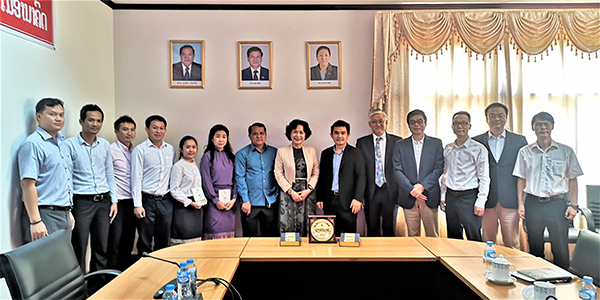
Pictured are the Chinese delegation and officials of the Special Economic Zone Administrative Committee of Vientiane including Prof. Tao Yitao (eighth from left) and Mr. Thongphat Vongskykeo (ninth from left)
After the meeting with the Special Economic Zone Administrative Committee of Vientiane, Prof. Tao Yitao and her delegation immediately headed for SDZ to attend the signing ceremony of tripartite cooperation among CCSEZR and BRRIICD, Shenzhen Zhongzujie Technology Co., Ltd. (Zhongzujie), and SDZ in the exhibition hall of Laos-China Joint Venture Investment Company, and the signing and inauguration ceremony of the Saysettha Branch of BRRIICD and the SDZ postdoctoral research base for theoretical economics of Shenzhen University in the presence of local officials.
The Saysettha Branch of BRRIICD is an academic think-tank co-founded by BRRIICD, Zhongzujie and SDZ to serve China’s BRI, and push the implementation of the Alignment and Cooperation Plan of the Bright Road Initiative and the BRI to boost cultural and academic exchanges across regions and foster creative talent with an international perspective.
The postdoctoral cooperative research base was jointly established by CCSEZR, Zhongzujie and Laos-China Joint Venture Investment Company by leveraging the resources of SDZ and the Saysettha Branch.
The base will focus researches on the construction and development model, path and institutional constraints and other issues of Laos-China Development Zone under the BRI framework.
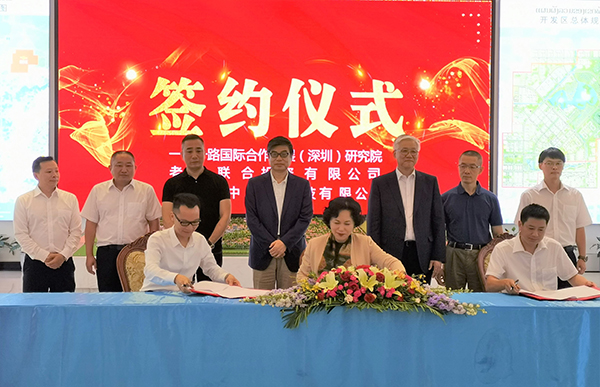
Signing ceremony:
from left are Mr. Luo Senbai (Chairman of Zhongzujie), Prof. Tao Yitao, Mr. Liu Hongyu (General Manager of Laos-China Joint Venture Investment Company).

Prof. Tao, Mr. Luo and Mr. Liu are unveiling the Saysettha Branch under the witness of the tripartite team
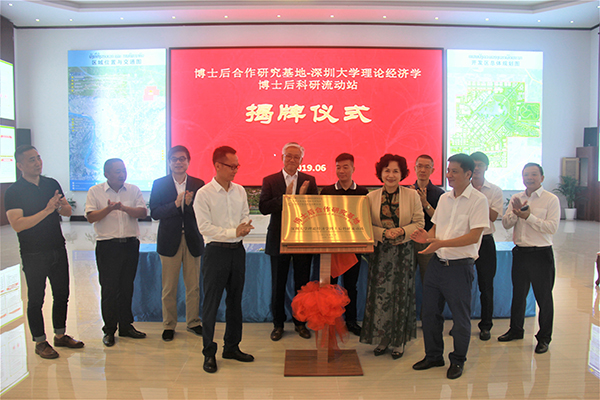
They are unveiling the postdoctoral research base under the witness of the tripartite team
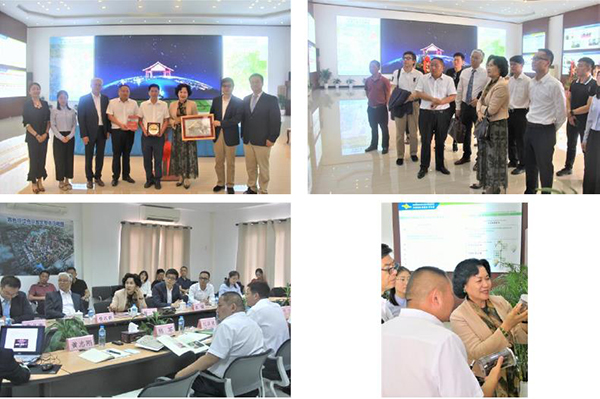
Prof. Tao and Laos-China Joint Venture Investment Company are exchanging souvenirs (upper left). Xiong Jun, Deputy General Manager of the company, is introducing SDZ to Prof. Tao and her delegation (upper right). Prof. Tao is introducing CCSEZR and BRRIICD to the company (lower left). Prof. Tao is learning about the products of SDZ (lower right).
Shenzhen Zhongzujie Technology Co., Ltd. (Zhongzujie) is a company set up under the national mass entrepreneurship and innovation project invested by China Merchants Startup Capital under the China Merchants Group. Zhongzujie is China’s first Internet-based platform dedicated to home rental services, a service management platform of pan-home industry chain and a (culture) management platform of home industry chain under the BRI. Laos-China Joint Venture Investment Company, co-founded with a total investment of USD 128 million from Yunnan Provincial Overseas Investment Co., Ltd., an overseas investment company of Yunnan Construction and Investment Holding Group Co., Ltd., and the Vientiane government of Laos, is the operating entity of SDZ.
Prof. Tao Yitao said that the Saysettha Branch, as the second overseas branch of BRRIICD after Shakalin University Branch, Kazakhstan and also the first one in Southeast Asia, could capitalize on BRRIICD’s connections, intellectual resources and the mature operation of projects including official training and entrepreneur investment investigation, to achieve success in promoting relevant projects between Laos and China, and even between China and Southeast Asian countries under the BRI framework. And she said that the establishment of the cooperative research base will better pool the intellectual resources of CCSEZR and the Postdoctoral Research Station of Theoretical Economics, and the Saysettha Branch to facilitate relevant researches. Mr. Luo Senbai, Chairman of Zhongzujie and Dean of the Saysettha Branch, indicated that the Saysettha Branch will conduct researches on projects along the Laos-China Railway and actively promote Lao officials to visit Shenzhen for training and Chinese entrepreneurs to investigate and invest in Laos.
Mr. Liu Hongyu said that through Professor Tao’s wonderful speech before the ceremony, he had a more intuitive and profound understanding of the Saysettha Branch and the cooperative research base, and was full of confidence in the prospect of the tripartite cooperation. He expressed that Laos-China Joint Venture Investment Company would facilitate and support their development.
On the morning of June 13, Prof. Tao’s delegation visited the National University of Laos (NUL) and met with Houngphet Chanthavong, Vice President of NUL and Associate Professor, Dr. Sithixay Xayavong, Director of China Research Center and Mr. Sengdeuanue Wayakone, Director of the International Relations Division. NUL is the only national university in Laos, merged from nine independent colleges in October 1996. With 36,000 students and 1,900 faculty and staff members, it boasts a complete talent fostering system from undergraduate to doctoral study.
And NUL is a member of Academic Consortium 21 and currently has partnerships with 84 foreign universities, including six Chinese ones. Prof. Tao Yitao introduced SZU to Vice President Houngphet Chanthavong with emphasis on the overseas student program, and said that SZU welcomes all outstanding students from NUL. Prof. Tao also introduced the Saysettha Branch and the cooperative research base, and proposed that the two sides could carry out more cooperation on SEZs and free trade zone (FTZ) through them. Mr. Houngphet Chanthavong was very interested in her cooperation initiative. He said that he will actively promote overseas student exchanges, fostering of in-service faculty, and Laos-China joint research projects. Vice President Houngphet Chanthavong also communicated with Prof. Tao Yitao in Russian, and warmly invited her to his office where we found the works of Chinese President Xi Jinping on the table.
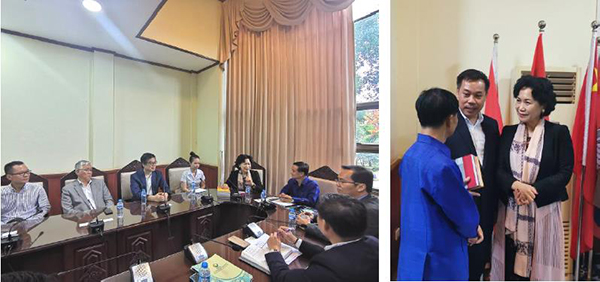
Prof. Tao Yitao is communicating with Vice President Houngphet Chanthavong (third from right in blue) in Russian(right).
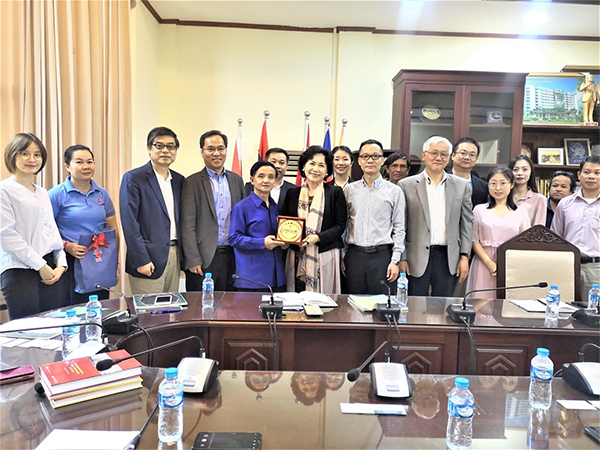
Prof. Tao is presenting SZU badge to Mr. Houngphet Chanthavong.
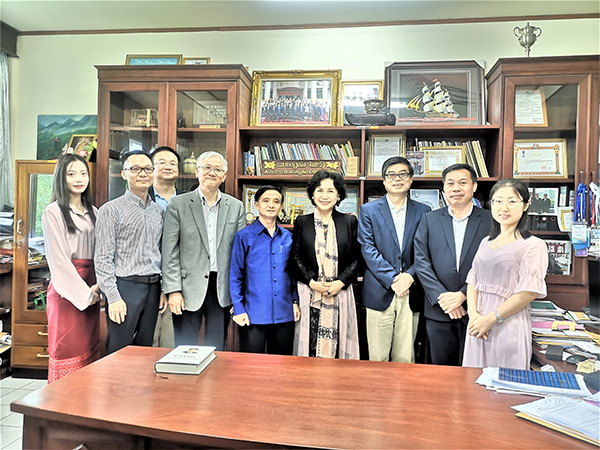
Prof. Tao’s delegation are visiting Mr. Houngphet Chanthavong’s office, and on the table are the works of Chinese President Xi Jinping.
On the afternoon of June 13, Prof. Tao Yitao and her delegation visited Ms. Sengdeuane Lachanthaboune, Minister of Education of Laos. Prof. Tao introduced to Ms. Sengdeuane Lachanthaboune CCSEZR and BRRIICD, and in particular the newly established Saysettha Branch and postdoctoral joint research base. She said that the Saysettha Branch would serve as a bridge to promote the exchanges of students and scholars between the two countries and Laos-China joint research projects. Ms. Sengdeuane Lachanthaboune was very interested in Prof. Tao's introduction and cooperation initiatives. She said that Laos had received help from China in many aspects, especially education. Ms. Sengdeuane Lachanthaboune said that she was really looking forward to the work of the Saysettha Branch and was willing to actively coordinate efforts between the Lao government and universities and the Saysettha Branch. She also endorsed Prof. Tao's initiative to establish a cooperation mechanism with the Lao government and NUL by proposing to sign a memorandum of understanding with NUL and the Lao Ministry of Foreign Affairs in advance, and to further discuss the details of cooperation.
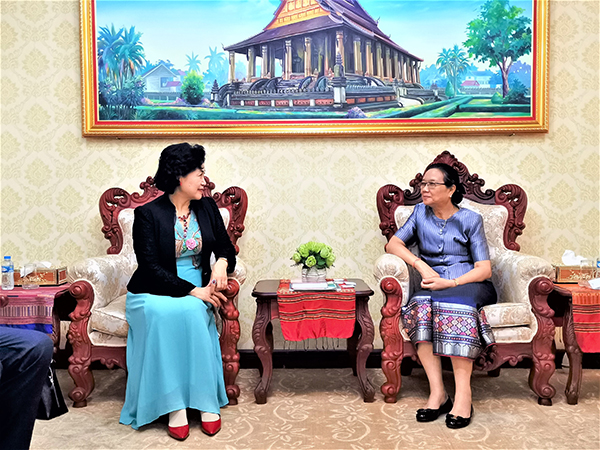
Prof. Tao is talking with Minister Sengdeuane Lachanthaboune.
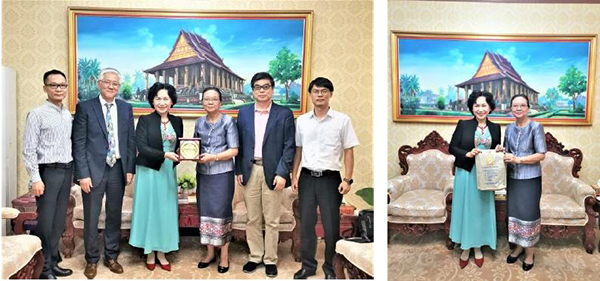
Prof. Tao is presenting SZU badge to Minister Sengdeuane Lachanthaboune (left). Minister Sengdeuane Lachanthaboune is presenting souvenir of the Ministry of Education (right).
After meeting with the Minister, Prof. Tao Yitao and her delegation went to the Wanxiang Branch of the Bank of China in downtown Vientiane City (Vientiane Branch) to meet with President Mr. Chen Keqin. President Chen Keqin introduced the basic information of the Vientiane Branch to the delegation. The Vientiane Branch, formally established on March 26, 2015 with its business license issued by the Bank of Lao P.D.R, covers all-round commercial banking operations. After opening, its profit has increased year by year and reached as much as RMB 100 million after tax in 2018. The Branch actively participates in the Belt and Road projects like Laos-China Railway and Non-ferrous Metal Resources Development, and is currently participating in the promotion of RMB clearing, the establishment of Lao Securities Exchange and mobile payment system. With employees from China and Laos using Chinese as the working language, the Branch especially favors Lao students who have studied in China. Prof. Tao Yitao introduced the newly established Saysettha Branch, saying that SZU and BRRIICD will use the Saysettha Branch as a bridge to actively respond to the Chinese government's BRI, and to promote cooperation between Laos and China by attracting Lao students for study in China, and conducting scholar exchanges, official training, entrepreneur investment investigation, and joint research under the BRI. President Chen Keqin quite agreed with Prof. Tao Yitao's proposal and said that the Vientiane Branch was willing to cooperate with the Saysettha Branch and lend data support for the research work of the institute, to jointly promote the cultural exchanges and economic development of both sides under the BRI framework.
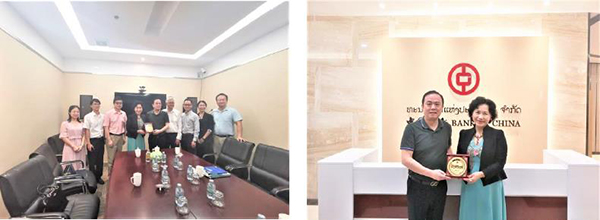
Prof. Tao is giving gifts to President Chen Keqin (left). Prof. Tao is taking a group photo with President Chen Keqin (right).
Prof. Tao Yitao and her delegation also visited the World Trade Center (WTC), Vientiane Center and Laos-China Friendship Association, and exchanged views with their respective heads. Boasting an advantageous geographical location, WTC is located in the downtown area of Vientiane, with the Vientiane traditional business district lying to the northwest, and only 4.5 kilometers to Wattay International Airport. Targeting higher-end consumers, WTC is a mixed-use lifestyle center that combines shopping, leisure, catering, entertainment, healthcare and other elements. The completed Vientiane Center Phase I has been put into operation, and the store of the international retail giant Parkson Retail Group in Vientiane Center will also be officially open to the public at the end of 2019. The WTC project will greatly change the laggard commerce of Vientiane, and promote its economic development by stimulating consumption of Lao and foreign tourists and creating more jobs for local people. In the Laos-China Friendship Association office, Prof. Tao Yitao and her delegation had a candid and in-depth exchange with President Qing Jikang. As an overseas Chinese who has lived in Laos for several decades, President Qing said that the overseas Chinese in Laos are very enthusiastic about the Laos-China cooperation under the BRI. He expected further people-to-people exchanges and cooperation between two countries and was willing to make contributions.
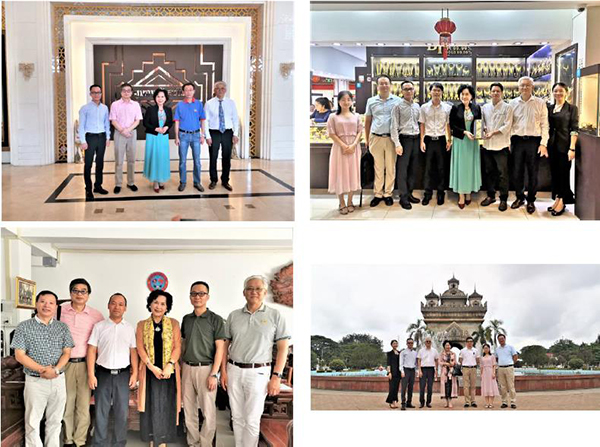
Group photo (upper left) with Mr. Ye Wei (second from right), COO of Lao International Development and Investment Co., Ltd. at WTC. Group photo (upper right) with Mr. Li Xiaodong (third from right), Chairman of Vientiane Center at Vientiane Center. Group photo (lower left) with President Qing Jikang (third from left). Visit to Patuxai (lower right), landmark of Vientiane.
On the tight-paced four-day trip, Prof. Tao Yitao and her delegation have achieved fruitful results. They not only built connections with Lao official authorities like the Special Economic Zone Administrative Committee of Vientiane, the Ministry of Education of Laos and NUL, but also made contacts with Chinese-funded institutions in Laos and implement two cooperation projects - the Saysettha Branch of BRRIICD and the cooperative research base of SDZ. In addition, the delegation also exchanged ideas with overseas Chinese in Laos, and more directly learned the enthusiasm of Chinese and overseas Chinese for the cooperation between Laos and China. During the visit, they also expressed their willingness on behalf of SZU and BRRIICD to collaborate with Laos, and the specific collaboration approaches proposed by the Chinese side. They expected to make good use of this visit to better promote exchanges and cooperation of academic communities, industry and civil society groups between Laos and China, and to respond with practical actions to implement President Xi Jinping's BRI.













